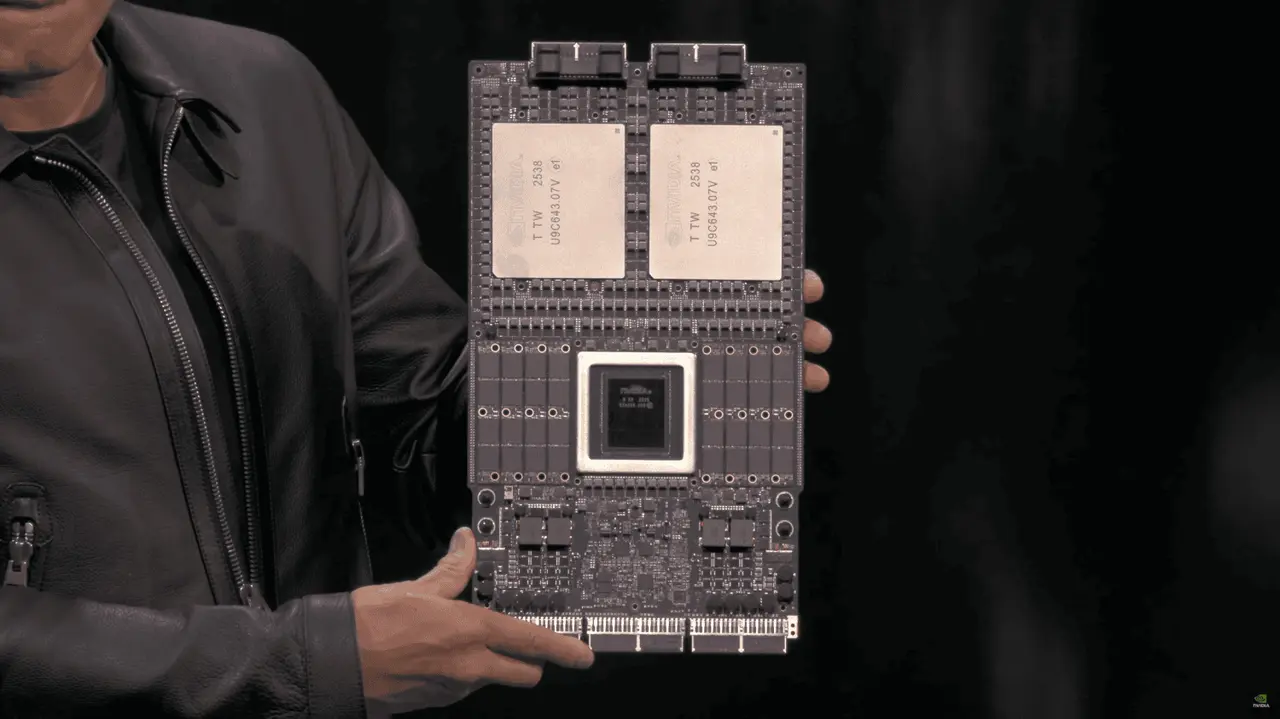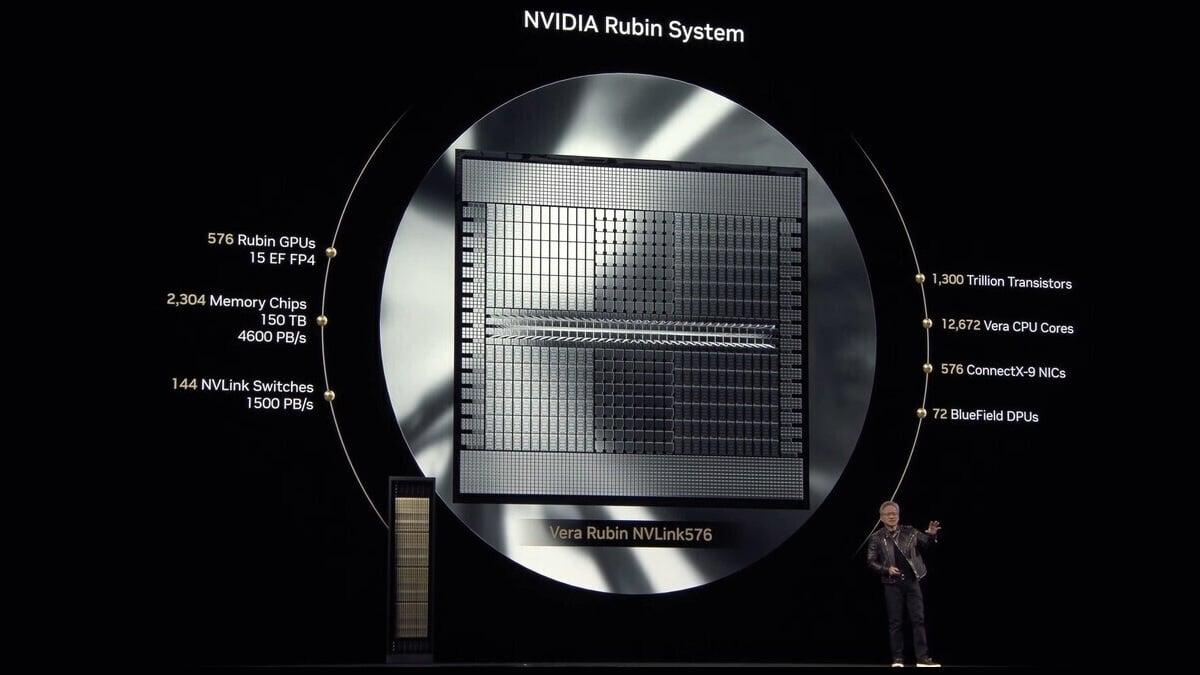NVIDIA's Next-Generation Rubin AI GPUs Enter Production with HBM4 Memory Samples
2 Sources
2 Sources
[1]
NVIDIA's next-gen Rubin GPUs enter production, gets HBM4 samples from all major DRAM makers
TL;DR: NVIDIA's next-generation Rubin AI GPUs have entered production, featuring advanced HBM4 memory and dual Reticle-sized GPU dies. Supported by TSMC's 50% increased 3nm capacity, Rubin powers the Vera Rubin NVL144 AI server launching in 2026, with the more powerful Rubin Ultra NVL576 debuting in 2027. NVIDIA's next-generation Rubin GPUs have reportedly entered production, with the company also having all major DRAM manufacturers provide it with HBM4 memory samples. NVIDIA CEO Jensen Huang has been in Taiwan over the last few days, visiting TSMC and having extensive discussions with the semiconductor giant, with NVIDIA seeking more 3nm production capacity for its Blackwell and Rubin AI GPUs, seeing TSMC increase 3nm production by 50%. In even more recent news, UDN reports that NVIDIA's next-gen Rubin AI GPUs have now entered production, and that the company has received HBM4 memory samples, too. NVIDIA only just received its first Rubin GPU at its labs a few days ago, and now we're at the production stage in just a few days, which is pretty crazy. UDN reports that regarding product and supply chain timing, Jensen said that demand for Blackwell is strong, and that it's not just for GPUs. Jensen explained: "NVIDIA is also manufacturing CPUs, network chips, switches, and many other chips related to Blackwell". In regards to Rubin, Jensen said that the next-gen Rubin chips are already entering the production line, adding: "we have already seen Rubin on the production line", with TSMC working very hard to support the related AI chip demand. Each of NVIDIA's next-gen Rubin GPUs are surrounded with a bunch of power circuitry, with each of the Rubin GPU chips sporting 8 HBM4 sites, and two Reticle-sized GPU dies. The Vera CPU features 88 cores and 176 threads of custom Arm-based CPU cores. NVIDIA's next-gen Vera Rubin NVL144 AI server platform will debut in 2026, while its monster Rubin Ultra NVL576 AI server drops in 2027 with upgraded Rubin Ultra GPUs, scaling from 144 GPUs to a huge 576 GPUs. Each of the Rubin Ultra GPUs are beefed up to four Reticle-sized chips (double the chips on Rubin) with gigantic 1TB of even faster HBM4E memory on 16 HBM sites. There's a total of 13TB of HBM4 memory with 75TB of fast memory, which is a 60% increase over GB300 NVL72, with 2 x the NVLINK and CX9 capabilities, rated at up to 260TB/sec and 28.8TB/sec, respectively. NVIDIA's new Vera Rubin NVL144 launches in the second half of 2026. However, in 2027, NVIDIA will unleash the NVIDIA Rubin Ultra NVL576 AI server platform, which will blow even the next-gen Vera Rubin NVL144. We have 15 Exaflops of FP4 inference power, and 5 Exaflops of FP8 Training capabilities, that represents a crazy 14x increase over the GB300 NVL72, with a whopping 4.6PB (petabytes, not terabytes) of HBM4 memory joined by 365TB of fast memory.
[2]
NVIDIA's Next-Gen Rubin GPUs Have Reportedly Entered Production, Also Secures HBM4 Samples From All Major DRAM Manufacturers
NVIDIA's next-generation Rubin GPUs have entered production, and the company has also secured samples of HBM4 memory from all major suppliers. A few weeks ago, NVIDIA's CEO, Jensen Huang, showcased the next-gen Vera Rubin Superchip for the first time at GTC 2025 in Washington. We got to see two super massive GPUs stacked together with the next-generation Vera CPU, and loads of LPDDR memory on the outskirts. The Vera Rubin Superchip will lay the framework for the next wave of AI computing in data centers, and it looks like there are some good reports regarding the production timeline. According to UDN, it is reported that during a recent visit to Taiwan, where Jensen Huang visited TSMC, he stated that the next-generation Rubin GPU is already entering the production line. This is big because just a few days back, Jensen had stated that they had received the first Rubin GPUs in the labs, so going from that to entering production in just a few days is groundbreaking. Regarding product and supply chain timing, Jensen Huang pointed out that demand for Blackwell is strong and not just for GPUs. "Nvidia is also manufacturing CPUs, network chips, switches, and many other chips related to Blackwell." He also revealed that the next-generation Rubin is already entering the production line. "We have already seen Rubin on the production line." TSMC is working very hard to support the related demand. via UDN While Rubin enters production, NVIDIA's current-gen Blackwell and Blackwell Ultra GPU demand remains unstoppable. This huge demand has prompted TSMC to boost its 3nm production by 50% to prepare well for Rubin GPUs. TSMC's President, C.C. Wei, has stated that NVIDIA wants more wafers and chips. When asked about how many chips NVIDIA has asked for, Wei replied that it was a "Secret". But there's no doubt that the number would be massive given the demand for Blackwell GPUs. In addition to the Rubin GPU, the report also stated that NVIDIA has already procured samples of next-gen memory, referring to HBM4, which will be featured on Rubin GPUs, from various manufacturers. Do note that NVIDIA has historically sourced DRAM from multiple companies, & given the recent shortages, they will prefer having everyone onboard. NVIDIA has already stated that the Rubin GPUs are expected to enter mass production around Q3 2026 or even earlier. The term "mass production" is different from production, so both are different scenarios. As for Rubin, the next standard for AI GPUs has already made headlines in a $100 billion partnership with OpenAI, which will leverage the next-gen accelerators for their data centers.
Share
Share
Copy Link
NVIDIA's next-generation Rubin AI GPUs have entered production ahead of schedule, with the company securing HBM4 memory samples from all major DRAM manufacturers. The development comes as TSMC increases 3nm production capacity by 50% to meet growing demand.
Accelerated Production Timeline
NVIDIA's next-generation Rubin AI GPUs have entered production in a remarkably compressed timeline, according to recent reports from Taiwan
1
2
. The development comes just days after NVIDIA CEO Jensen Huang announced that the company had received its first Rubin GPU samples in their laboratories, making the transition from initial testing to production phase extraordinarily rapid.
Source: TweakTown
During Huang's recent visit to Taiwan, where he held extensive discussions with TSMC executives, he confirmed that "we have already seen Rubin on the production line"
2
. This accelerated timeline demonstrates NVIDIA's aggressive push to maintain its dominance in the AI accelerator market as demand continues to surge across multiple sectors.Advanced Memory Technology Integration
A critical component of the Rubin GPU development involves next-generation memory technology. NVIDIA has successfully secured HBM4 memory samples from all major DRAM manufacturers, ensuring a diversified supply chain for the advanced memory modules
1
. Each Rubin GPU features eight HBM4 memory sites and incorporates dual Reticle-sized GPU dies, representing a significant architectural advancement over current generation products.The strategic approach of sourcing from multiple DRAM suppliers reflects lessons learned from recent memory shortages that have impacted the semiconductor industry. This diversification strategy aims to prevent supply bottlenecks that could potentially delay the rollout of Rubin-based systems.
Manufacturing Capacity Expansion
To accommodate the unprecedented demand for AI chips, TSMC has increased its 3nm production capacity by 50%
1
. TSMC President C.C. Wei acknowledged that NVIDIA is requesting substantial quantities of wafers and chips, though he declined to specify exact numbers, calling the information "secret"2
.This capacity expansion supports not only Rubin production but also the continued strong demand for NVIDIA's current Blackwell and Blackwell Ultra GPUs. Huang emphasized that the demand extends beyond just GPUs, noting that "NVIDIA is also manufacturing CPUs, network chips, switches, and many other chips related to Blackwell"
2
.Related Stories
Future Product Roadmap
NVIDIA has outlined an ambitious roadmap for Rubin-based systems. The Vera Rubin NVL144 AI server platform is scheduled to debut in 2026, featuring 144 GPUs and 13TB of HBM4 memory with 75TB of fast memory - representing a 60% increase over the current GB300 NVL72 system
1
.The even more powerful Rubin Ultra NVL576 system, planned for 2027, will scale up to 576 GPUs with upgraded Rubin Ultra chips featuring four Reticle-sized dies each. This system will include a massive 4.6 petabytes of HBM4 memory and deliver 15 Exaflops of FP4 inference power, representing a 14x increase over current generation systems
1
.References
Summarized by
Navi
[1]
Related Stories
NVIDIA Accelerates Next-Gen 'Rubin' AI GPU Launch, Featuring Advanced 3nm Process and HBM4 Technology
04 Dec 2024•Technology

NVIDIA's Rubin Platform: Next-Gen AI Architecture Set for 2026 Launch
23 Aug 2025•Technology

NVIDIA Accelerates AI Chip Development: Rubin GPUs and Vera CPUs Set for Early Debut
10 Jun 2025•Technology

Recent Highlights
1
Google launches Gemini 3 Flash as default AI model, delivering speed with Pro-grade reasoning
Technology

2
OpenAI launches GPT Image 1.5 as AI image generator war with Google intensifies
Technology

3
OpenAI launches ChatGPT app store, opening doors for third-party developers to build AI-powered apps
Technology





